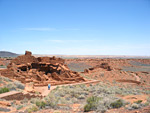This is a longish (6-page) article on Glen Canyon and Lake Powell. It has some of the history, the two major perspectives, and some of the personalities involved. McGivney suggests that nature may be undoing what man has done, politics be dammed. mjh
Backpacking Destinations – Paradise Found
Somebody forgot to tell Mother Nature that Glen Canyon was lost forever.
By Annette McGivney, BACKPACKER Southwest Editor, April 1, 2004
The Southwest is now 4 years into a drought that has more than halved Lake Powell, dropping water levels a record 100 feet.
At Northern Arizona University, hydrologists have developed a computer model that predicts that the reservoir’s remaining water will dry up with only 10 years of medium-scale drought. If severe drought continues–like the current dry spell that’s halved the reservoir in just 4 years–the end could come much sooner…. Two out of five marinas are landlocked; in fact, Hite has become a ghost town. Meanwhile, unemployment is rising, and visitation has dropped off by 40 percent. …
The saga of Glen Canyon Dam is long and knotty, but here’s the executive summary. Completed in 1963 on the Utah-Arizona border, the 50-story structure took 10 years, $330 million, and 4.9 million cubic yards of concrete to build. When Lake Powell was full, it contained 8.8 trillion gallons of water; it now holds 4.2 trillion. While a little water is drawn to supply local needs, the dam’s primary purpose has been to generate hydroelectricity. To that end, eight giant generators rumble away deep inside, producing up to 1.32 gigawatts at any given moment, enough juice to power a city of more than 1 million people. A digital sign inside the power station reports the gross earnings to date: just north of $2 billion.
Glen Canyon is one of six dams on the 1,400-mile-long Colorado River drainage, which stretches from Wyoming to where it fizzles out just inside Mexico. Like a conveyor belt, the system transports water from one impound to the next to serve 30 million people. …
As David Brower would lament when it was finished, Glen Canyon Dam was the product of political horse-trading. In the 1950s, the Bureau of Reclamation announced plans to build dams in Dinosaur National Monument and the Grand Canyon. Brower and the Sierra Club fought off the attempt to flood national parks but agreed not to dispute the dam in Glen Canyon, a place too wild and remote to have many champions and a place Brower didn’t visit until it was too late. Soon after the dam gates closed, the Sierra Club published a photo-heavy eulogy for what was lost: The Place No One Knew. …
In 1995, Ingebretsen founded the Glen Canyon Institute with the goal of decommissioning the dam. Today the nonprofit has 1,300 members, an annual budget of $200,000, two full-time staffers–and uncertain hope if the rains return. Ingebretsen is undeterred, aware that Mother Nature is giving his grassroots campaign a powerful boost. “Glen Canyon Dam serves no legitimate purpose,” he insists, as he prepares to launch a screed about species extinction and pork-barrel patronage. “It was built for political reasons, and it remains today for political reasons.” …
“A free-flowing Colorado isn’t worth a god damn to anybody,” insists Floyd Dominy, the former Bureau commissioner who famously wrote that creating Lake Powell seems to bring man “closer to God.” At 94, Dominy is as full of brash, head-scratching hyperbole as ever. “I can’t even find the words to describe the beauties of Lake Powell. I consider Glen Canyon dam my biggest accomplishment in life.” …
We walk toward the mouth of Clear Creek, where water gurgles from algae-covered rocks. Ingebretsen wants to show me that Glen Canyon is not dead, not buried beneath a flood of sediment. “You can see the plant life is already coming back,” he gloats. “The silt quickly flushes out and the algae, ferns, and frogs return.”





